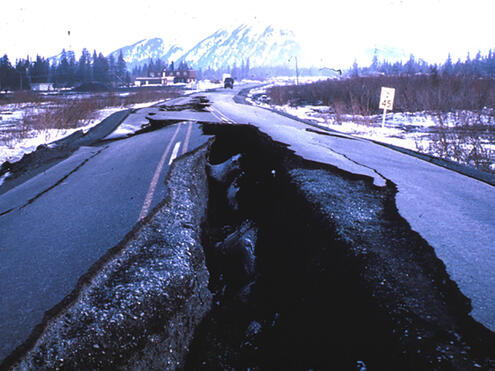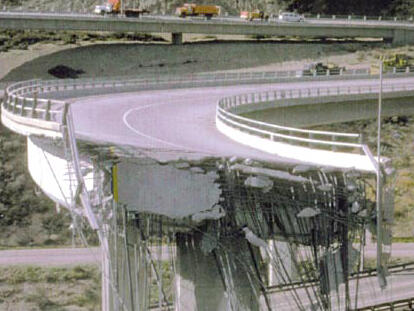POWER of PLATE TECTONICS
Explore how plate tectonics affect our planet.
Earthquakes
Earthquakes can cause the ground to shake and crack apart. Earthquakes can be very powerful. And if they occur in or near areas where people live, they can make buildings collapse, bridges sway, and roads buckle.
But not all earthquakes are powerful enough to cause damage. In fact, earthquakes are happening all the time, on land and in the ocean. Most are so small that people don't even feel them.

An Alaskan earthquake caused the ground to crack apart.

The highway in California collapsed during and earthquake.
An earthquake is the sudden movement of Earth's crust. Earthquakes occur along fault lines, cracks in Earth's crust where tectonic plates meet. They occur where plates are subducting, spreading, slipping, or colliding. As the plates grind together, they get stuck and pressure builds up. Finally, the pressure between the plates is so great that they break loose. Depending on how much pressure has built up, the ground may tremble slightly or shake forcefully.
Scientists describe the intensity of an earthquake using the Richter Scale. It measures earthquakes on a scale of 1 to 10. People barely feel a magnitude 3 earthquake, and windows might rattle at magnitude 4. A magnitude 6 earthquake is considered major, causing houses to move and chimneys to fall. The largest earthquake on record had a magnitude of 9.5.
Image Credits:
Alaska earthquake and San Francisco earthquake images, courtesy of USGS




 Biodiversity
Biodiversity
 Brain
Brain
 Genetics
Genetics
 Marine BiOLogy
Marine BiOLogy
 MicrobiOLogy
MicrobiOLogy
 PaleontOLogy
PaleontOLogy
 ZoOLogy
ZoOLogy
 AnthropOLogy
AnthropOLogy
 ArchaeOLogy
ArchaeOLogy
 Astronomy
Astronomy
 Climate Change
Climate Change
 Earth
Earth
 Physics
Physics
 Water
Water
